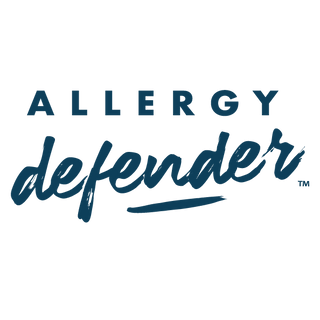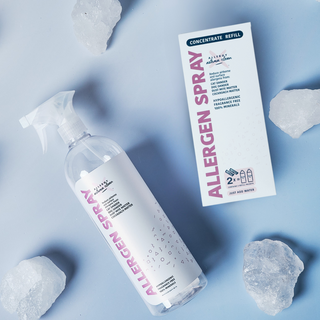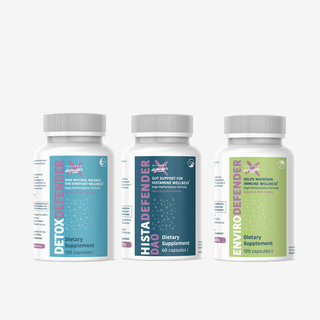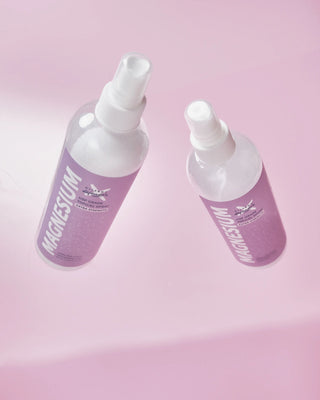Pet dander sticks to everything (carpets, walls, curtains, air ducts, bedding), stays airborne, and remains active for 30+ weeks, requiring 8 months for complete removal. Comprehensive cleaning includes frequent vacuuming with HEPA filters, using rubber gloves for crevices/baseboards, wiping hard surfaces weekly, changing MERV 13-rated HVAC filters monthly (twice monthly for multiple pets), carpet cleaning (vacuum before and spray after), using air purifiers in bedrooms, and applying Allergy Asthma Clean Allergen Spray by Allergy Defender generously in every room. Create pet-free bedroom sanctuary, avoid scented products (candles, air fresheners contain 4,000+ chemicals), and spray allergen spray weekly or daily for severe allergies.
Key Takeaways:
- Pet dander persistence – sticks to all surfaces, remains airborne moving between rooms, stays active 30+ weeks; complete removal takes 8 months of consistent cleaning
- Strategic vacuuming essential – use HEPA vacuum (removes 99% airborne particles), rubber gloves for baseboards/crevices, change bags when full, wash reusable filters often
- HVAC filter maintenance critical – use MERV 13-rated filters (80-90% dust spot efficiency, removes bacteria/viruses); change monthly for one pet, twice monthly for multiple pets; higher ratings above 13 can damage older units
- Allergy Asthma Clean Allergen Spray by Allergy Defender application – spray generously in every room (not just pet areas), use weekly or daily for severe allergies, spray in air then vacuum, apply on upholstery and carpets
- Create pet-free bedroom sanctuary – no pets allowed, change clothes before entering (leave in hamper outside), clean bedding weekly, dust weekly, spray allergen spray daily if needed
- Avoid indoor air pollutants – eliminate candles, air fresheners, harsh cleaning products, essential oils containing 4,000+ chemicals that worsen asthma/allergies; brush pets outdoors; consider professional HVAC cleaning
Think this is extreme? I know a woman who moved into a rental that previously housed two dogs that shed a lot, a black lab, and an older dachshund. She was very allergic to pets. The location was perfect and quiet, just what she needed since she is a light sleeper. The carpets were cleaned professionally. So, you’re thinking, that’s it, right? Move right in. Not so fast. She knew her intense allergies to pets, so here’s what she did to assure herself she could actually live in this dwelling. She bought a brand new, expensive vacuum cleaner with incredible suction. It sucked up a staggering amount of dog hair (even though the carpet had been professionally cleaned, mind you). Next, she took Allergy Defender's Allergen Spray solution and sprayed it in the air, generously in every room. Pet dander reduced? You bet. Problem solved.
If you’d like to enjoy the relief this woman experienced, we’ve got some ideas, but first, a bit of “science.”
Pet dander’s quirkiness
Pet dander sticks to everything: carpets, walls, curtains, mini blinds, ceiling fans, inside air ducts, bedding, clothes, doors—you get the picture.
Pet dander is airborne friendly! As you move from one room to the next, it sails into other rooms, even if Fluffy or Fido are confined to only one room.
Pet dander can stay active for up to 30+ weeks. Removing pet dander from your household takes eight incredibly long months! Need we say reducing pet dander in your home requires attention to detail and patience.
The following are ideas on keeping allergens to a minimum.
How to remove pet dander from soft surfaces
Soft surfaces include upholstery and carpet. You can vacuum chairs, couches, carpets and you should. Frequently. In addition to vacuuming to cut down on cat or dog dander, we suggest using a rubber glove. It works really best in the crevices of upholstery and along the baseboards where carpet is installed. Have you ever vacuumed and noticed it does not suck up hair and dirt right next to the wall? Next time, run your rubber-gloved hand on the carpet against the wall. You’d be surprised at the dirt and pet dander that you pick up.
Control dust and dander on hard surfaces
Spring Cleaning is not a fad. Where cat and dog dander-causing allergies are concerned, thorough cleaning is pretty much weekly. Here’s an idea when time is short: wipe down flooring near baseboards instead of cleaning the whole floor (pet dander and hair will tend to collect outside of pathways). And in the bathroom, don’t forget to wipe behind the toilet. I know that spot gets dirty very quickly in my house.
Air filters are important, too
Your heating or air conditioning unit works off and on all day, blowing heat or cool into your home, and pet dander gets drawn into your system's air filter, so, it’s important to change your filter monthly because a dirty one can harm your heating and cooling unit and won’t help keep allergens at bay. If you have more than one pet, change it every 2 weeks. Read more about air filters here.
Air filters are numbered from low to high
The industry standard is called MERV (minimum efficiency reporting value). This reporting value ranges from 6-13, the highest number being the most able to filter out dirt, dander, pollen, bacteria, viruses and more. The lowest number 6 is usually made of fiberglass “threads” and can filter only larger particles such as dust.
“If you suffer from breathing problems such as allergies or asthma, then use a filter with a MERV 13 rating. MERV 13-rated filters have a dust spot efficiency of 80-90%, and they are highly efficient filters both for residential and commercial use. MERV 13 filters remove a higher range of particulates, including larger amounts of bacteria and even some viruses, and they are best for people suffering from breathing problems.” according to AirFilters.com site.
A higher-rated filter (above 13) could dampen the airflow in your HVAC and could damage the unit. So, if you have an older unit or just don’t know what filter to use, call your local HVAC company and see what they recommend. I just called one in my area, and they said to use the number 13.
Caution if shopping at big lumber stores
Since MERV is the industry standard, you’d think that would be good enough, right? Guess again! Two other ratings have surfaced, compliments of Home Depot and Lowes. Lowes has an online dropdown menu where you can choose MERV-rated brands. Lowe’s own rating is called MPR (Micro-Particle Performance Rating). Home Depot created their brand labeled FPR (Filter Performance Rating). They also mention MERV on their site to help you choose the filters that correspond to their rating.
Should you buy an air purifier? Will it make sleeping easier?
Your home's air quality can have a significant impact on not only your breathing but your sleep. Poor air quality can disrupt sleep patterns and lead to various health issues. Pet dander and allergens, for instance, are known to become airborne. They also have a fondness for fabrics and surfaces in our homes. This means that even with regular cleaning of your home and grooming your pet, it can be challenging to entirely eliminate pet dander from the indoor air. Inhaling these particles can trigger allergic reactions and negatively affect sleep quality.
To address this issue, using an air purifier becomes crucial for pet owners. An air purifier can effectively remove particles that find their way into our noses and lungs during sleep. Filtering out pet dander and allergens helps create a cleaner and healthier sleeping environment, reducing the risk of allergic reactions and thus promoting better sleep.
Beyond pet-related concerns, air purifiers are beneficial for other allergens as well. Dust, pollen, and other airborne pollutants commonly found indoors can also affect sleep quality. Breathing in these particles while sleeping can lead to congestion, coughing, and discomfort, resulting in restless nights and, you guessed it, fragmented sleep.
Investing in an air purifier can help mitigate these issues by removing these particles from the air. Creating a cleaner and purified indoor environment improves air quality and reduces the likelihood of respiratory distress during sleep. This, in turn, promotes optimal sleep health and allows individuals to wake up feeling refreshed and energized. I'm all for that. How 'bout you?
Purchase a HEPA air purifier
Just like the HEPA vacuum cleaner, these handy air purifiers clean your air to 99%. Consider putting an air purifier in your bedroom since you spend half your time sleeping there. Best Products.com and Wirecutter.com are both good sites for determining what’s best for your pet-free zone.
Carpet cleaning for pet dander
If you’re about to clean your carpet, vacuum before. Vacuuming before brings up the dry stuff- dirt, dust, hair, and what you have. Vacuuming before will also make your carpet cleaning water cleaner and that means it’s better for cleaning your carpet. In other words, dirty water could cause dirty carpets or staining. After your carpet is cleaned, spray Allergen Spray in the air and on your carpet. Pet dander will be floating in the air, so it’s important to keep those allergens down to the ground where they will dry out; that's how Allergen Spray works. Allergens float in the air. Allergen Spray grabs onto the allergen, drops them to the ground, and dries them out so they can't bother you.
Vacuum cleaners, bags and filters
Change vacuum cleaner bags when full. Wash reusable ones often. Let dry out before installing it back into your vacuum. Let’s be honest, we all avoid this unpleasant task because it’s dirty and dusty! But delaying this task only adds dust and dirt back into your home, and dust and dirt can reduce the flow of air to your vacuum. If you’re purchasing a new vacuum, buy one with a HEPA (high-efficiency particulate absorbing) filter. These are very good for eliminating pet dander and reducing pet allergies. The filters reduce airborne particles by up to 99%!
Don’t be exposed
By all means, create a safe place in your home. We suggest your bedroom, where pets are not allowed. Since pet dander is sticky, change out of your clothes before stepping into your room. Put them in a laundry basket and bring the hamper into your room so your pet can’t sleep on your clothes while you’re snoozing. Clean your bedroom often. Clean your bedding weekly. Yes, even dust weekly. Spray Allergy Defender's Allergen Spray daily if need be. Your bedroom should be the cleanest room in your home, your safe spot away from pet dander so you can breathe easier and calm your mind and body from any allergens. Can’t you just feel the relaxing “ahhh” now?
Helping to keep your air quality clean
Candles, harsh cleaning products, and, yes, even essential oils can add to poor indoor air quality. Not only that, but these products are harmful to your health. Why? Scented products contain chemicals that can cause serious problems for many people, especially those with asthma, allergies, and environmental illness. Do you know that approximately 4,000 chemicals are used to make fragrances, and several hundred can be used in a single product? Why breathe them in?
Well, we hope that gives you a solid understanding of how to clean and what to use to get cleaner air.
4 tips to remove pet dander using Allergen Spray and 11 tips for general cleaning.
Tip #1
Spray every room generously, not just where your pet frequents.
Tip #2
Spray at least once a week, more often, even daily, if allergies are a real concern.
Tip #3
Spray the product in the air, let it settle, then vacuum.
Tip #4
Use Allergen Spray by Allergy Defender on your upholstered furniture, and use a rubber glove to gather hair hiding inside crevices
Why Allergy Defender works on pet dander
This product is unique in the allergy-removing arena. It is made of minerals. These minerals attach themselves to allergens, drop them to the ground, and dry them up so they can be easily vacuumed.
General Tips
Tip #5
Clean your carpet frequently. Vacuum before your carpets are cleaned.
Tip #6
Wipe down flooring alongside baseboards once a week. Don’t forget the bathroom. And if you spend just 10 minutes a day cleaning, at the end of the week, you'll have spent an hour and 10 minutes to a cleaner home seemingly without effort!
Tip #7
If you have one pet, replace MERV-rated air filters once a month. If you have two pets, change them twice a month. Be sure to budget for this expense.
Tip #8
If possible, purchase a HEPA filter vacuum cleaner.
Tip #9
Reduce your exposure to pet dander by creating one pet-free room in your home.
Tip #10
Refuse to use candles or air fresheners. These products contribute to poor indoor air quality, and if you have allergies or asthma, this is simply not a good idea.
Tip #11
Brush your pet outdoors. Have someone else do it if you're allergic.
Tip #12
Have your HVAC system professionally cleaned.
Tip #13
Wash your face and hands frequently to remove allergens.
Tip #14
When you're at your limit, talk to an allergist. Oftentimes, you might think you’re allergic to pets only to discover that your allergist finds you’re allergic to something else!
Tip #15
If you visit friends who have pets, consider wearing a mask. We’re not kidding! It can keep pet dander to a minimum. And who knows, it might even prevent having to use stronger medication such as an inhaler.
And what about the woman who had professionals clean her carpet and bought a new vacuum to suck up the pet dander? It’s been seven months now and she’s still allergy and pet dander free!
Allergy Defender is a whole-house solution. Spray it in every room to reduce pet dander, even if your pet is allowed in only one room. Why bother with OTC drugs when a simple, safe spray can do the job? Consider purchasing a bottle today for an allergy-free home.




